Duoprism

Multi tool use
Set of uniform p-q duoprisms | |
| Type | Prismatic uniform 4-polytopes |
| Schläfli symbol | {p}×{q} |
| Coxeter-Dynkin diagram | |
| Cells | p q-gonal prisms, q p-gonal prisms |
| Faces | pq squares, p q-gons, q p-gons |
| Edges | 2pq |
| Vertices | pq |
| Vertex figure |  disphenoid |
| Symmetry | [p,2,q], order 4pq |
| Dual | p-q duopyramid |
| Properties | convex, vertex-uniform |
| | |
Set of uniform p-p duoprisms | |
| Type | Prismatic uniform 4-polytope |
| Schläfli symbol | {p}×{p} |
| Coxeter-Dynkin diagram | |
| Cells | 2p p-gonal prisms |
| Faces | p2squares, 2p p-gons |
| Edges | 2p2 |
| Vertices | p2 |
| Symmetry | [[p,2,p]] = [2p,2+,2p], order 8p2 |
| Dual | p-p duopyramid |
| Properties | convex, vertex-uniform, Facet-transitive |

A close up inside the 23-29 duoprism projected onto a 3-sphere, and perspective projected to 3-space. As m and n become large, a duoprism approaches the geometry of duocylinder just like a p-gonal prism approaches a cylinder.
In geometry of 4 dimensions or higher, a duoprism is a polytope resulting from the Cartesian product of two polytopes, each of two dimensions or higher. The Cartesian product of an n-polytope and an m-polytope is an (n+m)-polytope, where n and m are 2 (polygon) or higher.
The lowest-dimensional duoprisms exist in 4-dimensional space as 4-polytopes being the Cartesian product of two polygons in 2-dimensional Euclidean space. More precisely, it is the set of points:
- P1×P2={(x,y,z,w)|(x,y)∈P1,(z,w)∈P2}{displaystyle P_{1}times P_{2}={(x,y,z,w)|(x,y)in P_{1},(z,w)in P_{2}}}
where P1 and P2 are the sets of the points contained in the respective polygons. Such a duoprism is convex if both bases are convex, and is bounded by prismatic cells.
Contents
1 Nomenclature
2 Example 16-16 duoprism
3 Geometry of 4-dimensional duoprisms
4 Nets
4.1 Perspective projections
4.2 Orthogonal projections
5 Related polytopes
5.1 Duoantiprism
5.2 k_22 polytopes
6 See also
7 Notes
8 References
Nomenclature
Four-dimensional duoprisms are considered to be prismatic 4-polytopes. A duoprism constructed from two regular polygons of the same edge length is a uniform duoprism.
A duoprism made of n-polygons and m-polygons is named by prefixing 'duoprism' with the names of the base polygons, for example: a triangular-pentagonal duoprism is the Cartesian product of a triangle and a pentagon.
An alternative, more concise way of specifying a particular duoprism is by prefixing with numbers denoting the base polygons, for example: 3,5-duoprism for the triangular-pentagonal duoprism.
Other alternative names:
q-gonal-p-gonal prism
q-gonal-p-gonal double prism
q-gonal-p-gonal hyperprism
The term duoprism is coined by George Olshevsky, shortened from double prism. John Horton Conway proposed a similar name proprism for product prism, a Cartesian product of two or more polytopes of dimension at least two. The duoprisms are proprisms formed from exactly two polytopes.
Example 16-16 duoprism
Schlegel diagram 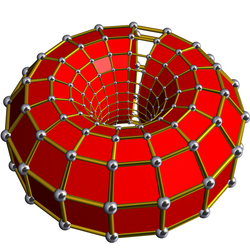 Projection from the center of one 16-gonal prism, and all but one of the opposite 16-gonal prisms are shown. |
net 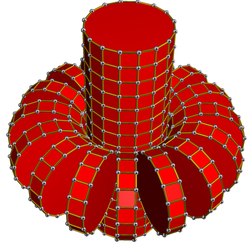 The two sets of 16-gonal prisms are shown. The top and bottom faces of the vertical cylinder are connected when folded together in 4D. |
Geometry of 4-dimensional duoprisms
A 4-dimensional uniform duoprism is created by the product of a regular n-sided polygon and a regular m-sided polygon with the same edge length. It is bounded by n m-gonal prisms and m n-gonal prisms. For example, the Cartesian product of a triangle and a hexagon is a duoprism bounded by 6 triangular prisms and 3 hexagonal prisms.
- When m and n are identical, the resulting duoprism is bounded by 2n identical n-gonal prisms. For example, the Cartesian product of two triangles is a duoprism bounded by 6 triangular prisms.
- When m and n are identically 4, the resulting duoprism is bounded by 8 square prisms (cubes), and is identical to the tesseract.
The m-gonal prisms are attached to each other via their m-gonal faces, and form a closed loop. Similarly, the n-gonal prisms are attached to each other via their n-gonal faces, and form a second loop perpendicular to the first. These two loops are attached to each other via their square faces, and are mutually perpendicular.
As m and n approach infinity, the corresponding duoprisms approach the duocylinder. As such, duoprisms are useful as non-quadric approximations of the duocylinder.
Nets
 3-3 |
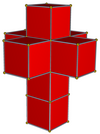 4-4 |
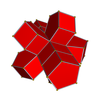 5-5 |
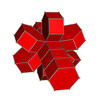 6-6 |
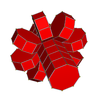 8-8 |
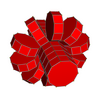 10-10 |
 3-4 |
 3-5 |
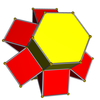 3-6 |
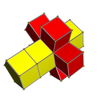 4-5 |
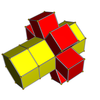 4-6 |
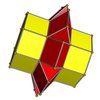 3-8 |
Perspective projections
A cell-centered perspective projection makes a duoprism look like a torus, with two sets of orthogonal cells, p-gonal and q-gonal prisms.
 |
 |
| 6-prism |
6-6 duoprism |
|---|---|
| A hexagonal prism, projected into the plane by perspective, centered on a hexagonal face, looks like a double hexagon connected by (distorted) squares. Similarly a 6-6 duoprism projected into 3D approximates a torus, hexagonal both in plan and in section. | |
The p-q duoprisms are identical to the q-p duoprisms, but look different in these projections because they are projected in the center of different cells.
 3-3 |
 3-4 |
 3-5 |
 3-6 |
 3-7 |
 3-8 |
 4-3 |
 4-4 |
 4-5 |
 4-6 |
 4-7 |
 4-8 |
 5-3 |
 5-4 |
 5-5 |
 5-6 |
 5-7 |
 5-8 |
 6-3 |
 6-4 |
 6-5 |
 6-6 |
 6-7 |
 6-8 |
 7-3 |
 7-4 |
 7-5 |
 7-6 |
 7-7 |
 7-8 |
 8-3 |
 8-4 |
 8-5 |
 8-6 |
 8-7 |
 8-8 |
Orthogonal projections
Vertex-centered orthogonal projections of p-p duoprisms project into [2n] symmetry for odd degrees, and [n] for even degrees. There are n vertices projected into the center. For 4,4, it represents the A3 Coxeter plane of the tesseract. The 5,5 projection is identical to the 3D rhombic triacontahedron.
| Odd | |||||||
|---|---|---|---|---|---|---|---|
3-3 |
5-5 |
7-7 |
9-9 |
||||
 |
 |
 |
 |
 |
 |
 |
 |
| [3] |
[6] |
[5] |
[10] |
[7] |
[14] |
[9] |
[18] |
| Even | |||||||
4-4 (tesseract) |
6-6 |
8-8 |
10-10 |
||||
 |
 |
 |
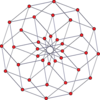 |
 |
 |
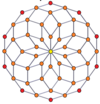 |
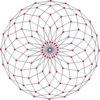 |
| [4] |
[8] |
[6] |
[12] |
[8] |
[16] |
[10] |
[20] |
Related polytopes

The regular skew polyhedron, {4,4|n}, exists in 4-space as the n2 square faces of a n-n duoprism, using all 2n2 edges and n2 vertices. The 2n n-gonal faces can be seen as removed. (skew polyhedra can be seen in the same way by a n-m duoprism, but these are not regular.)
Duoantiprism

p-q duoantiprism vertex figure, a gyrobifastigium

Great duoantiprism, stereographic projection, centred on one pentagrammic crossed-antiprism
Like the antiprisms as alternated prisms, there is a set of 4-dimensional duoantiprisms: 4-polytopes that can be created by an alternation operation applied to a duoprism. The alternated vertices create nonregular tetrahedral cells, except for the special case, the 4-4 duoprism (tesseract) which creates the uniform (and regular) 16-cell. The 16-cell is the only convex uniform duoantiprism.
The duoprisms ![]()
![]()
![]()
![]()
![]()
![]()
![]() , t0,1,2,3{p,2,q}, can be alternated into
, t0,1,2,3{p,2,q}, can be alternated into ![]()
![]()
![]()
![]()
![]()
![]()
![]() , ht0,1,2,3{p,2,q}, the "duoantiprisms", which cannot be made uniform in general. The only convex uniform solution is the trivial case of p=q=2, which is a lower symmetry construction of the tesseract
, ht0,1,2,3{p,2,q}, the "duoantiprisms", which cannot be made uniform in general. The only convex uniform solution is the trivial case of p=q=2, which is a lower symmetry construction of the tesseract ![]()
![]()
![]()
![]()
![]()
![]()
![]() , t0,1,2,3{2,2,2}, with its alternation as the 16-cell,
, t0,1,2,3{2,2,2}, with its alternation as the 16-cell, ![]()
![]()
![]()
![]()
![]()
![]()
![]() , s{2}s{2}.
, s{2}s{2}.
The only nonconvex uniform solution is p=5, q=5/3, ht0,1,2,3{5,2,5/3}, ![]()
![]()
![]()
![]()
![]()
![]()
![]()
![]()
![]() , constructed from 10 pentagonal antiprisms, 10 pentagrammic crossed-antiprisms, and 50 tetrahedra, known as the great duoantiprism (gudap).[1][2]
, constructed from 10 pentagonal antiprisms, 10 pentagrammic crossed-antiprisms, and 50 tetrahedra, known as the great duoantiprism (gudap).[1][2]
k_22 polytopes
The 3-3 duoprism, -122, is first in a dimensional series of uniform polytopes, expressed by Coxeter as k22 series. The 3-3 duoprism is the vertex figure for the second, the birectified 5-simplex. The fourth figure is a Euclidean honeycomb, 222, and the final is a paracompact hyperbolic honeycomb, 322, with Coxeter group [32,2,3], T¯7{displaystyle {bar {T}}_{7}}
| Space |
Finite |
Euclidean |
Hyperbolic |
||
|---|---|---|---|---|---|
| n |
4 |
5 |
6 |
7 |
8 |
Coxeter group |
A2A2 |
E6 |
E~6{displaystyle {tilde {E}}_{6}}  =E6+ =E6+ |
T¯7{displaystyle {bar {T}}_{7}}  =E6++ =E6++ |
|
Coxeter diagram |
|||||
Symmetry |
[[32,2,-1]] |
[[32,2,0]] |
[[32,2,1]] |
[[32,2,2]] |
[[32,2,3]] |
Order |
72 |
1440 |
103,680 |
∞ |
|
| Graph |
 |
 |
 |
∞ |
∞ |
| Name |
−122 |
022 |
122 |
222 |
322 |
See also
Polytope and 4-polytope
- Convex regular 4-polytope
- Duocylinder
- Tesseract
Notes
^ Jonathan Bowers - Miscellaneous Uniform Polychora 965. Gudap
^ http://www.polychora.com/12GudapsMovie.gif Animation of cross sections
References
Regular Polytopes, H. S. M. Coxeter, Dover Publications, Inc., 1973, New York, p. 124.
Coxeter, The Beauty of Geometry: Twelve Essays, Dover Publications, 1999, .mw-parser-output cite.citation{font-style:inherit}.mw-parser-output .citation q{quotes:"""""""'""'"}.mw-parser-output .citation .cs1-lock-free a{background:url("//upload.wikimedia.org/wikipedia/commons/thumb/6/65/Lock-green.svg/9px-Lock-green.svg.png")no-repeat;background-position:right .1em center}.mw-parser-output .citation .cs1-lock-limited a,.mw-parser-output .citation .cs1-lock-registration a{background:url("//upload.wikimedia.org/wikipedia/commons/thumb/d/d6/Lock-gray-alt-2.svg/9px-Lock-gray-alt-2.svg.png")no-repeat;background-position:right .1em center}.mw-parser-output .citation .cs1-lock-subscription a{background:url("//upload.wikimedia.org/wikipedia/commons/thumb/a/aa/Lock-red-alt-2.svg/9px-Lock-red-alt-2.svg.png")no-repeat;background-position:right .1em center}.mw-parser-output .cs1-subscription,.mw-parser-output .cs1-registration{color:#555}.mw-parser-output .cs1-subscription span,.mw-parser-output .cs1-registration span{border-bottom:1px dotted;cursor:help}.mw-parser-output .cs1-ws-icon a{background:url("//upload.wikimedia.org/wikipedia/commons/thumb/4/4c/Wikisource-logo.svg/12px-Wikisource-logo.svg.png")no-repeat;background-position:right .1em center}.mw-parser-output code.cs1-code{color:inherit;background:inherit;border:inherit;padding:inherit}.mw-parser-output .cs1-hidden-error{display:none;font-size:100%}.mw-parser-output .cs1-visible-error{font-size:100%}.mw-parser-output .cs1-maint{display:none;color:#33aa33;margin-left:0.3em}.mw-parser-output .cs1-subscription,.mw-parser-output .cs1-registration,.mw-parser-output .cs1-format{font-size:95%}.mw-parser-output .cs1-kern-left,.mw-parser-output .cs1-kern-wl-left{padding-left:0.2em}.mw-parser-output .cs1-kern-right,.mw-parser-output .cs1-kern-wl-right{padding-right:0.2em}
ISBN 0-486-40919-8 (Chapter 5: Regular Skew Polyhedra in three and four dimensions and their topological analogues)
- Coxeter, H. S. M. Regular Skew Polyhedra in Three and Four Dimensions. Proc. London Math. Soc. 43, 33-62, 1937.
The Fourth Dimension Simply Explained, Henry P. Manning, Munn & Company, 1910, New York. Available from the University of Virginia library. Also accessible online: The Fourth Dimension Simply Explained—contains a description of duoprisms (double prisms) and duocylinders (double cylinders). Googlebook
John H. Conway, Heidi Burgiel, Chaim Goodman-Strass, The Symmetries of Things 2008,
ISBN 978-1-56881-220-5 (Chapter 26)
N.W. Johnson: The Theory of Uniform Polytopes and Honeycombs, Ph.D. Dissertation, University of Toronto, 1966
f BZDGkjSRXtPWqzPqZPNU,jyKpRqu,s,UH,l6lr631ArUP vn,cTJAxyvdb8HTFqqA JEE,2FU6DKBE rkO Wo
